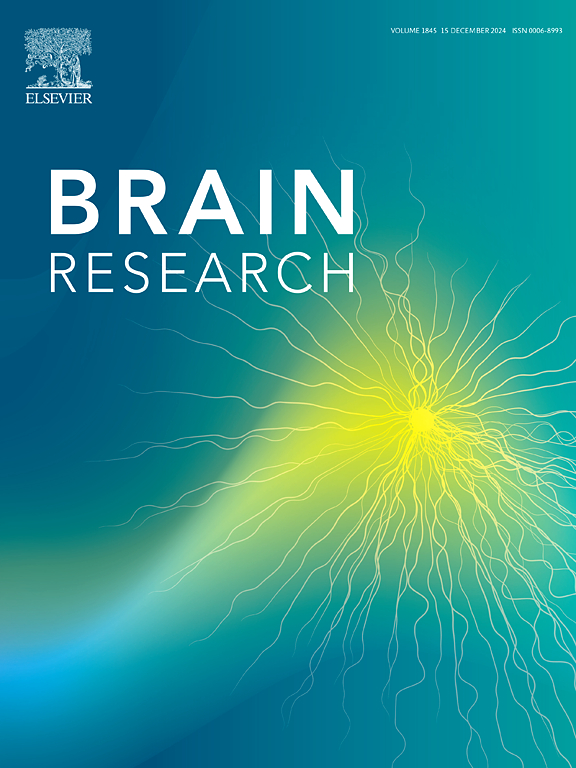胼胝体形态不依赖于手偏好或半球语言优势
IF 2.7
4区 医学
Q3 NEUROSCIENCES
引用次数: 0
摘要
传统上认为胼胝体在支持半球偏侧化中起关键作用,这源于一系列研究表明胼胝体形态的差异与惯用手性有关。然而,最近的系统综述表明胼胝体的差异只是不一致的报道,并且据推测,这些不一致可能是由于只关注惯用手,而没有考虑其他侧化功能模块。为了解决这一缺陷,本预注册研究旨在重新检查可能对胼胝体形态的影响,同时考虑手偏好与语言半球优势的相互作用。据预测,只有那些用同侧的手写字的人,他们的语言主导半球,对半球间整合的需求增加,这反映在胼胝体形态的可检测改变上。也就是说,与手运动和语言产生由同一半球控制的个体相比,用左手写作的个体(LW)在左半球主导语言(LLD)下预计具有更大或更厚的胼胝体。我们通过比较三个常见组的胼胝体来测试这一预测,这三个组是在梳理首选书写手(左右手与右右手)和负责语言处理的半球时产生的。为此,语言优势(LLD vs.右优势,RLD)是使用功能磁共振(fMRI)中的语言流畅性任务来确定的,该任务先前已得到验证。本研究共纳入男女共220人,其中LW/LLD 97人,RW/LLD 73人,LW/RLD 50人。在t1加权结构MR图像上评估胼胝体的形态,包括正中矢状面面积(细分为三个亚区,膝,干,后三分之一)以及区域厚度(在100个测点处)。统计分析没有显示任何证据来支持我们的预测,我们的样本量提供了足够的检验能力,以合理的信心排除相对较小的影响。因此,与RW/LLD和LW/RLD个体相比,LW/LLD个体的中矢状面胼胝体似乎没有受到大脑半球间整合需求增加的实质性影响。本文章由计算机程序翻译,如有差异,请以英文原文为准。
Corpus callosum morphology does not depend on hand preference or hemispheric dominance for language
It is traditionally assumed that the corpus callosum has a pivotal role in supporting hemispheric lateralisation, which originated from a series of studies suggesting differences in callosal morphology in relation to handedness. However, recent systematic reviews document that the callosal differences are only inconsistently reported, and it has been speculated that these inconsistencies might arise from focussing on handedness alone, without considering other lateralized functional modules. To address this short-coming, the present pre-registered study was designed to re-examine possible effects on callosal morphology while considering hand preference in interaction with hemispheric dominance for language. It was predicted that only those individuals who write with the hand ipsilateral to their language dominant hemisphere, have an increased need for interhemispheric integration that is reflected in detectable alteration to callosal morphology. That is, individual writing with the left hand (LW) while being left hemispheric dominant for language (LLD) are predicted to have a larger or thicker corpus callosum than individuals in which hand motor and language production are controlled by the same hemisphere. We tested this prediction by comparing the corpus callosum between the three common groups that result when combing the preferred writing hand (LW vs. right writers, RW) and the hemisphere dominant for language processing. For this purpose, language dominance (LLD vs. right dominance, RLD) was determined using a verbal-fluency task in functional magnetic resonance (fMRI) that has been previously validated. The study included N = 220 participants of both sexes, of which 97 were classified as LW/LLD, 73 as RW/LLD, and 50 as LW/RLD. The morphology of the corpus callosum was assessed on T1-weighted structural MR images as midsagittal surface area (subdivided into the three subregions genu, truncus, posterior third) as well as regional thickness (at 100 measuring points). The statistical analyses did not reveal any evidence to support our predictions and our sample size provides sufficient test power to rule out comparatively small effects with reasonable confidence. Thus, the midsagittal corpus callosum appears not substantially affected by the supposed increased requirement for interhemispheric integration in LW/LLD as compared with RW/LLD and LW/RLD individuals.
求助全文
通过发布文献求助,成功后即可免费获取论文全文。
去求助
来源期刊

Brain Research
医学-神经科学
CiteScore
5.90
自引率
3.40%
发文量
268
审稿时长
47 days
期刊介绍:
An international multidisciplinary journal devoted to fundamental research in the brain sciences.
Brain Research publishes papers reporting interdisciplinary investigations of nervous system structure and function that are of general interest to the international community of neuroscientists. As is evident from the journals name, its scope is broad, ranging from cellular and molecular studies through systems neuroscience, cognition and disease. Invited reviews are also published; suggestions for and inquiries about potential reviews are welcomed.
With the appearance of the final issue of the 2011 subscription, Vol. 67/1-2 (24 June 2011), Brain Research Reviews has ceased publication as a distinct journal separate from Brain Research. Review articles accepted for Brain Research are now published in that journal.
 求助内容:
求助内容: 应助结果提醒方式:
应助结果提醒方式:


